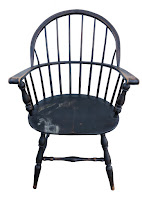 |
| Rocking Chair Before Saggy seat! |
This rocking chair was estimated to be about 150 years old. My customer’s grandmother had installed the pink fabric (seen on the photo on the left) in the 1930’s, so it definitely had seen a lot of wear since then, which was over 80 years ago. Unbelievably, the fabric had maintained its overall condition, with no rips or other damage, but the seating itself had sunken in the center. Sagging happens over time, no matter how the chair had been originally constructed. And this one was reupholstered over 80 years ago, so sagging was not unusual. The upholstery work was done very well with unseen nails and tiny stitches. Quality lasts.
 |
| Rocking Chair after Higher padding in the seat |
Chairs have a lot of surface area, therefore they take a long time to strip and refinish, because you must remove all the original stain prior to sanding and re-staining it. (See video at bottom). The detail in this chair with its dowels on the front arms and across the front crosspiece took the most amount of time, but the rockers themselves were also a challenge because they were harder to reach because of their location beneath the chair. I spent five long afternoons to remove all the finish, sand and re-stain the chair. Two coats of polyurethane applied over 24 hours was the final step prior to moving ahead with installing the new fabric.
 |
| Unfinished Rocker |
Prepping the chair for fabric is essential and involves replacing the original webbing with new webbing, making sure it’s nice and taut so the seat is built with a strong foundation. This chair had seat and back webbing, as well as front and back fabric on the backing. The seat area of the chair had some damage. It was broken on one side and the webbing had come apart, causing the sagging seat. I repaired the damage before installing the new webbing.
 |
| New Webbing After Refinishing |
The most difficult part of putting fabric on any chair with arms, is making sure you cut the fabric towards the arms with a “Y” cut. This gives you enough fabric to wrap it around each arm before folding and tucking the fabric securely next to either side of the arms prior to securing it with staples. It’s a long, labor-intensive process and should not be rushed. Installing the fabric properly requires concentration with no distractions so that you can focus on what you’re doing. If not, you may make costly mistakes.
I got lucky with this chair, because the back of the arms had a screw and were removable, so that I could slide the fabric beneath it, which made the installation nice and clean with no cut lines required. Not all chairs have that option, in which case you have to make those tricky cuts, but sometimes you get lucky. After I finished the front, making sure the fabric was tightly wrapped and secured to the back, I adding the final piece of fabric, folding the edges and finished it with piping.














































